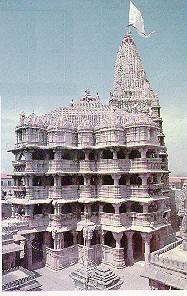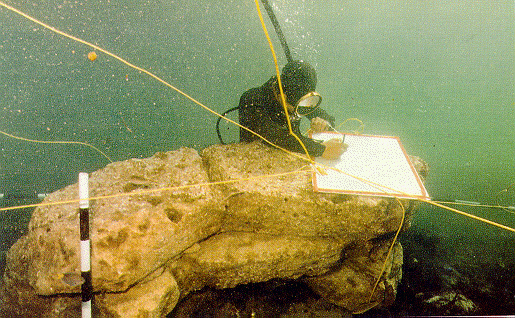Dwarka on the west coast of India, is a well known ancient port, now believed to have been submerged. The excavations carried out during 1979 in the Dwarkadhish Temple Complex revealed three temple remains. In all, eight settlements can be distinguished at Dwarka.
 The first settlement made in the 15th century B.C. was submerged or washed
away and so also the second one made in the 10th century B.C. After a long
gap the third settlement was made in the 1st century B.C./A.D. as suggested
by the Red Polished Ware and copper coins known as Karshapanas.
It is during this phase that Temple I, was built. The lime-plastered surface
of its stone masonry still retaining a few lines of red ocher painting
suggests that the plinth was open to view above the then working level.
After the first temple was destroyed the second temple came to be built
on the ruins of the first. When the second temple was also destroyed, the
third temple was built in the 9th century. It was perhaps in the 12th century
a storm-wave blew away the roof leaving only the walls and plinth. The
fourth temple came into existence soon after. The present temple of Dwarkadhish
is the fifth in the series. Temples I to V represent respectively settlements
III to VII and the modern town is the eighth settlement at Dwarka. It is
this sequence finding of which led to present explorations at Dwarka.
The first settlement made in the 15th century B.C. was submerged or washed
away and so also the second one made in the 10th century B.C. After a long
gap the third settlement was made in the 1st century B.C./A.D. as suggested
by the Red Polished Ware and copper coins known as Karshapanas.
It is during this phase that Temple I, was built. The lime-plastered surface
of its stone masonry still retaining a few lines of red ocher painting
suggests that the plinth was open to view above the then working level.
After the first temple was destroyed the second temple came to be built
on the ruins of the first. When the second temple was also destroyed, the
third temple was built in the 9th century. It was perhaps in the 12th century
a storm-wave blew away the roof leaving only the walls and plinth. The
fourth temple came into existence soon after. The present temple of Dwarkadhish
is the fifth in the series. Temples I to V represent respectively settlements
III to VII and the modern town is the eighth settlement at Dwarka. It is
this sequence finding of which led to present explorations at Dwarka.
A marine archaeologist has to gather as much information as possible from literary sources and oral tradition before selecting a site for excavation. He has to visualise the plan and extent of the submerged city and salient features, if any.
During 1983-1992 underwater archaeological explorations have been carried out almost every year in Dwarka waters. The successive underwater investigations off Dwarka in about 4 to 12 m water depth have revealed the presence of a number of submerged stone building blocks such as remains of wall, pillar and bastion and also stone anchors of various types like three-holed, prismatic and triangular were noticed in various places. SDDE and SCUBA systems were used for the underwater exploration along with ‘Aquazepp’ the underwater scooter. The survey boats were chartered and were equipped with underwater camera, underwater TV system and airlift equipments for exploration and excavation.
At Dwarka approximately 9,80,000 sq. m area was explored between the water depth of 3 to 12 m off Samudranarayana Temple. Diving operations were undertaken in various locations covering 8 zones of detailed investigations. The important findings were documented mainly with still photography, underwater video filming and underwater drawings. The position of the objects were fixed with the help of sextants. The Geophysical survey equipment also used in Dwarka waters for survey purposes.
 The
onshore explorations nearby Bet Dwarka revealed the presence of Late Indus
seal depicting 3 headed animal, earthen vessel inscribed in the characters
of Indus-Brahmi transition phase of about 1500 B.C. and the large quantity
of pottery similar to Lustrous Red Ware bowl and the Red Ware dishes, dish-on-stand,
perforated jar and in curved bowls which are datable to 1600-1500 B.C.
in Dwarka, Rangpur and Prabhas.
The
onshore explorations nearby Bet Dwarka revealed the presence of Late Indus
seal depicting 3 headed animal, earthen vessel inscribed in the characters
of Indus-Brahmi transition phase of about 1500 B.C. and the large quantity
of pottery similar to Lustrous Red Ware bowl and the Red Ware dishes, dish-on-stand,
perforated jar and in curved bowls which are datable to 1600-1500 B.C.
in Dwarka, Rangpur and Prabhas.
Among antiquities which are crucial to dating and determining the cultural sequence of submerged cities of Dwarka and Bet Dwarka are the Late Indus type seal, chert blades, an inscribed votive jar, 3-holed stone anchors, a stone-mould, an Olpin with loop-handle and a sprinkler-neck in pottery are important. The chronological sequence proposed on the basis of the antiquities can be corroborated by distinct ceramic wares.
A small rectangular seal (20 x 18 mm) of conch shell with a perforated button at the back was found in trench UW6 of Bet Dwarka. A composite animal motif representing the short horned bull, unicorn and goat are engraved in an anticlockwise direction.
A votive pottery vessel inscribed in post-Harappan script analogous to
Semitic script. The inscription read Mahagachashah pa (mahakachashah-pa)
meaning ‘Sea Lord; Protect’ in Old Indo-Aryan-Iranian language.
Preliminary underwater explorations off Somnath were carried out during 1992 and 1995. The surveyed area falls into 3 zones, where diving operations were undertaken at 15 locations. The findings were a three-holed triangular stone anchor and a three-holed prismatic stone anchor measuring in length about a meter and a one holed circular stone object similar to that found in Dwarka. The findings were documented. The positions of objects were fixed with the help of GPS System and plotted on map.
![]()